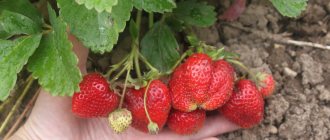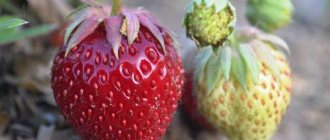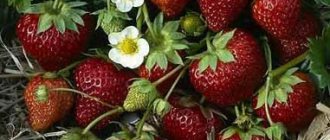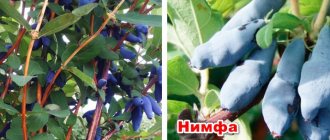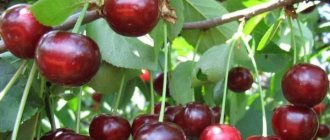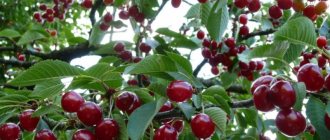Breeders are developing new varieties of strawberries every year. The Zephyr strawberry variety will appeal to any gardener, as it is characterized by early yield. Not so long ago, strawberries of the “Zephyr” variety appeared in our regions, but in European countries they have known about them for a long time. "Zephyr" comes from Denmark. Back in 1960, this crop began to be grown in Norway. It follows that plant bushes can be grown even in harsh climatic conditions. It can be grown both in open ground and in a greenhouse. Ideal for commercial cultivation, as it tolerates transportation well and has a high yield level.
Main characteristics
For clarity, we present the main data in table form:
| Parameter | Characteristic |
| Culture | Strawberry (Fragaria ananassa) |
| Ripening period | Early or ultra early |
| Fruiting | One-time (non-repairable), friendly |
| Photoperiodic type | Short daylight hours |
| Productivity | High: about 1 kg per bush |
| Mass of berries | Average 17-30 g, maximum up to 50-60 g |
| Fruit shape | Blunt conical or broadly rounded, comb, ribbed |
| Berry color | Dark red with a glossy sheen |
| Pulp | Pink, juicy, dense |
| Purpose | Universal |
| Educational ability | High (up to 20 whiskers per bush) |
| Productive life cycle | 3-4 years or more (depending on climatic conditions and intensity of agricultural technology) |
| Sustainability | The variety is winter-hardy, relatively drought-resistant; is immune to powdery mildew and brown leaf spot, and is slightly susceptible to gray rot of fruits; susceptible to strawberry mite damage |
| Inclusion in the State Register of the Russian Federation | Turned off |
Distinctive features of the variety are erect leaves and powerful peduncles, which are located above the foliage and practically do not lie to the ground under the weight of large, filling fruits.
Diseases and pests
In general, Zephyr is not afraid of most diseases typical for garden strawberries. It is advisable to carry out the treatment using a solution prepared from 2-3 tablespoons of copper sulfate diluted with a bucket of water. This will increase the individual’s immunity and improve its resistance to diseases.
Alas, sometimes the variety suffers from gray mold. This problem spreads throughout the bush. The most affected are the berries, which become very soft and covered with a gray coating. Fundazol, Topsin M, Euparen are used for treatment. Treatment activities begin in early April and are carried out about 4 times, maintaining an interval of a week and a half.
If we talk about parasites, Zephyr is most afraid of the strawberry mite. It often begins its activity at high humidity. Typically, the tick prefers the young foliage of the plant, feeding on the juices. The leaves begin to shrink and turn yellow. Later they die off.
To get rid of the pest, it is recommended to get rid of any plant debris around the strawberries in autumn and spring. When you plan to plant a young individual, you need to treat them: dip them, roots up, in a solution of karbofos at the rate of 75 grams per bucket of water. Also in spring, the use of Karate or Arrivo preparations is allowed. In the summer, when the mustache is formed, they recommend Mitak, Omite. In autumn - Isofen.
Advantages of the variety
Among the main advantages of the Zephyr strawberry are:
- early or super-early ripening with quick and friendly yield. In open ground, fruiting begins in the second half of May, in greenhouse conditions - from the end of April - the first ten days of May;
- frost resistance and endurance in adverse weather conditions. Plants under snow cover or a layer of organic mulch safely tolerate severe frosts (−16...−35 ℃) and are relatively resistant to drought;
- ease of care and resistance to diseases. The variety is undemanding to soil types, and is little susceptible to leaf spot, gray fruit rot, powdery mildew, and fusarium;
- high commercial and consumer qualities of berries, their transportability and versatility of purpose.
Zephyr strawberries have excellent transportability, shelf life, and are in high consumer demand
Based on the results of an expert assessment conducted in 2002–2006. by specialists of the All-Russian Selection and Technological Institute of Horticulture and Nursery Growing under the leadership of Professor S. D. Aitzhanova at the collection site of the Kokinsky stronghold (Bryansk region), the variety “Zephyr” was among the most resistant (at the level of immunity) to powdery mildew and brown spot leaves.
Based on the degree of freezing under conditions of harsh snowless winters, the variety fell into the group of low-winter hardy.
Fertilizing strawberries Zephyr
Strawberries need regular watering, once every 1-1.5 weeks. But during the period when the fruits are set, it is necessary to increase the frequency of watering, since if there is a lack of moisture, the berries can be small and dry. When watering, it is necessary to avoid getting water on the fruits and leaves.
More on the topic: Non-repairing strawberry varieties for Siberia
Strawberries of the Zephyr variety are fed twice a month with mineral fertilizers. You can use a mixture of superphosphate, potassium salt, ammonium nitrate, taking them in a 1:1:1 ratio. It is not recommended to use fertilizers that contain chlorine.
In addition, every year, after fruiting is completed, the soil must be fertilized. To do this, use a solution of infused bird droppings or manure.
Commercial and consumer qualities of berries
The berries are large (weighing on average 17-30 g, maximum up to 50-60 g), without internal voids, and do not become smaller by the end of fruiting. The shape can be blunt-conical or broadly rounded, comb-shaped, ribbed. Thanks to powerful peduncles that do not lie close to the ground, the fruits are located high and do not come into contact with the soil, which makes harvesting easier and reduces the risk of spoilage. With uniform lighting and good ventilation, the berries ripen very quickly, acquiring a dark red color and a pronounced glossy shine.
The fruits fill to large sizes and, when fully ripe, acquire a dark red color (with a crimson tint) and a glossy shine.
Assessments of the taste qualities of the Zephyr strawberries, according to reviews from gardeners, vary greatly. Some describe the berries as richly sweet with tender and juicy pulp, having a light and airy texture (corresponding to the name), and a pleasant aroma. Others consider the taste dessert-like, rather ordinary. The berries have a universal culinary purpose: they are suitable for fresh consumption and all types of processing, and they retain their shape and density well when cooked and frozen.
The yield of the variety depends on external factors and growing conditions; potentially up to 1 kg of berries can be obtained from a bush. An important advantage of “Zephyr” compared to other early varieties is considered to be the return of a consistently high yield already in the first year after planting.
Collection, storage and use of crops
The Zephyr strawberry harvest begins early, in the second decade of June. The berries ripen almost simultaneously. They should be collected in the morning or evening hours. For transportation, it is better to collect the berries with the stem and place them in shallow plastic containers. The berries tolerate transportation well.
Strawberries can be stored in the refrigerator for 4-5 days. Marshmallow has a very pleasant taste and, as foreign sources say, “is a good snack, but not suitable for jam.” The berries are very good for freezing and do not lose their appearance or shape.
Strawberry harvest Marshmallow - video
Flaws
The disadvantages of the variety include:
- intensive whisker formation (up to 20 whiskers per bush). On the one hand, it allows you to propagate the variety without problems, obtaining a large number of stepsons. On the other hand, it leads to thickening of plantings and rapid depletion of the plant’s strength. Therefore, unnecessary mustaches must be constantly trimmed, preventing the formation of the first daughter rosettes, and the plantings must be renewed at least every 3-4 years;
- susceptibility to damage by the strawberry mite.
The “Zephyr” variety is perfect for cultivation in protected soil, including on an industrial scale
Growing and care
Strawberries Zephyr will bring a good harvest if you properly care for them throughout the growing season.
Watering
Despite its drought resistance, the plant must be watered at least once a week. During flowering and ovary formation: every 2-3 days. The optimal irrigation option is watering using a drip system.
If there is a lack of moisture, the plant will not die, but the fruits will become small and not so juicy
Loosening, weed control
Tiring weeding and loosening can be avoided if you mulch the plantings with straw, forest litter, sawdust, or cover them with black agrofibre. If you use black plastic film, weeds will not grow, there is no need to loosen, but there is a danger of developing a fungal infection on the roots.
Removing a mustache
According to gardeners, the Zephyr variety produces up to 30 mustaches per season. This quickly leads to thickening of the bed and depletion of the plant and soil. Whiskers that are not used for reproduction should be cut off before rosettes appear on them.
Top dressing
To get tasty fruits from Zephyr, you need to regularly replenish the reserves of nutrients and microelements in the soil:
- In early spring, use organic matter or a solution consisting of ammonium nitrate and urea (1 tablespoon each) diluted in 10 liters of water. 0.5 liter is enough for a strawberry bush. An excess is harmful and will lead to a decrease in sugar content. Organic matter is diluted with water in the following proportion: mullein (1:10), chicken manure (1:20);
- The second spring feeding is done in May. 1 tbsp. A spoonful of potassium nitrate is diluted in 10 liters of water. 0.5 l is added. fertilizers for the plant. This solution can also be applied to leaves.
- In summer you can use nettle leaves and stems. Pour the herb with water in a barrel and leave to ferment for a week, stirring daily. Dilute the mixture with water in a ratio of 1:10.
After harvesting, strawberries are fed with complex mineral fertilizers with a high content of phosphorus and potassium. The plant does not need nitrogen during this period, because increasing green mass will reduce winter hardiness.
Mineral fertilizers give good results, but they must be used exactly following the instructions and doses
Pest and disease control
Zephyr is resistant to many diseases. Rarely suffers from powdery mildew and fusarium. If outbreaks of infectious diseases of berry crops have been noticed in the garden plot, for prevention in early spring, strawberries are treated with a 1% solution of copper sulfate.
During flowering and fruiting, such spraying can no longer be carried out. The variety is prone to damage by the strawberry mite. The drug Actellik, used in the spring and after harvest, has proven itself well in the fight against pests. During flowering, you can treat with phytoverm; this drug belongs to biological protection agents.
Planting crops with phytoncidal properties around the perimeter - garlic, marigolds, calendula - will help repel many pests from the strawberry bed.
Preparing for winter
Zephyr strawberries are able to overwinter in regions of Russia where the thermometer drops below 35℃, provided that the plantings are covered with snow or mulch.
To increase winter hardiness, apply 1 liter under strawberries in the fall. potassium sulfate (30 g) and nitrophoska solution (40 g), diluted in 10 liters of water. You should carefully inspect the bushes in front of the shelter and spud up the bare roots.
Agrotechnical recommendations
The bushes of this variety are low and compact, so they can be planted quite densely - at a distance of 20-25 cm from each other. Experts consider mid-August to be the optimal time for planting, so the plants have time to take root well and prepare for winter, and are capable of full fruiting the following season.
The variety is propagated using daughter rosettes; alternative methods (dividing bushes and germination from seeds) are used extremely rarely
The variety is unpretentious in terms of care. Prefers open, level, sunny areas, but can also grow in partial shade. “Zephyr” is relatively drought-resistant, but cannot do without watering, especially in the initial stages of growth, flowering and fruiting. We must not forget about timely preventive treatments against pests. Plants are considered undemanding in terms of soil type, but develop better in nutritious, fairly light soil with neutral acidity. Organic fertilizers are recommended: humus and peat, slurry, chicken droppings. Before and during fruiting, it is necessary to remove tendrils from bushes that are not intended for reproduction, and in the fall it is recommended to trim off old leaves and cover the beds for the winter with coniferous spruce branches, straw or agricultural fabric.
Features of growing strawberries
Growing Zephyr strawberries is not difficult, as they are quite easy to care for. However, you need to follow some rules when planting it. In order for the variety to bear fruit well and not get sick, a number of conditions must be observed:
- The soil. Zephyr itself can grow in non-nutrient soils. But in such conditions it will not be possible to get an excellent harvest. Firstly, strawberries (any variety) do not like acidic soil. Secondly, it is advisable to plant seedlings in a fertilized area. Thirdly, it is recommended to add sand to the soil to make it lighter.
- The area where strawberries will be grown must be loose and free of weeds.
- Strawberries of this variety can be planted in spring or late summer (approximately mid-August). Later planting is dangerous, as there is a chance that the seedlings will not survive on the site.
The landing diagram itself looks like this:
- First, dig a hole 15-25 cm deep. It all depends on the length of the roots.
- The distance between the holes should be about 35 cm. Strawberries cannot be planted thicker, as the bushes will be more susceptible to fungal diseases.
- The row spacing should be at least 60 cm. This will greatly simplify harvesting and caring for strawberries.
- After the hole is dug, it is watered with water. Each hole requires 1 liter of water.
- When the water is absorbed, a seedling is placed in the hole. Its root system is straightened (always vertically) and sprinkled with soil.
- The soil is compacted and at the end of planting, each bush is watered (1 liter per plant).
Reviews
Yuri, 50 years old, Krivoy Rog
In the Zephyr variety, I would note a very friendly and simultaneous ripening of berries on all bushes. Some call it one of the best for growing under film, but in our conditions other early varieties turned out to be much more interesting in taste: Olvia, Clery and Rosanna. So I’ll throw out Zephyr along with Chamora.
Elmira, 42 years old, Yoshkar-Ola
We have been growing this variety for several years. The bushes are strong and healthy, bloom profusely, and their berries ripen even earlier than those of Honey. The harvest is delivered quickly, literally in three harvests. The fruits are large and do not shrink towards the end, transportable, attractive in appearance and without voids inside. The taste is sweet with gentle sourness, the aroma is pleasant. Great for all summer desserts and winter preparations. The variety is not capricious, hardy, has increased winter hardiness, reproduces easily, so it suits us in all respects.
Natalya, 46 years old, Moscow
I came to the conclusion that I will refuse the Zephyr strawberry variety. It has been growing on our site for three years now. The yield is not bad and the berries really have a “marketable” appearance: beautiful, evenly crimson in color, heavy, even, clean, practically not subject to rot. Transportability and keeping quality are also excellent: they do not wrinkle or leak during transportation and storage. But I grow strawberries not for sale, but for myself and my family for food. And, despite the appetizing name, the taste just doesn’t suit me - it’s too banal, inexpressive, the aroma is weakly expressed.
Nikolay, 41 years old, Zaporozhye region.
In our conditions, strawberries of the Zephyr variety turn out marshmallow-sweet and tasty. From a small plantation (only 10 square meters), the entire berry harvest is spent on family, friends and neighbors. I have never taken it to the market yet. It is one of the first to ripen and leaves very quickly. Productivity is rather weak, but resistance to diseases (even with minimal treatments) and to weather changes is encouraging.
Reproduction
Propagation of strawberries of the “Zephyr” variety is no different from any other. It can be propagated using tendrils, seeds, and also by dividing the bush. Some believe that “Zephyr” is not convenient to propagate using seeds, but experienced gardeners claim that they grow into good bushes that bear fruit.
This type of plant has a large number of tendrils, due to which most experts give their preference to this method of propagation. To do this, you need to choose the most prolific bushes and use the first rosettes located on each tendril. The rest are simply removed.
As for dividing the bush, this method is most often used for beardless or small mustache types of crops. At the end of the season, more than 10 growth points may appear on the plants. Such bushes are divided and only one pair of roots is left on each part. If each part has a sufficient number of roots, then a small part of the leaves is left. If there are few roots, then all the foliage should be removed.
In order for the root system of the Zephyr strawberry to develop well, it needs to be constantly hilled up and the soil raked up to the rosettes. But, avoid covering the growing point of the plant. Otherwise it will simply die. Important! To ensure your strawberries take root as best as possible, carefully monitor the soil moisture.
If at the time of dividing the strawberry variety some of the horns are left without roots, do not worry. They can also be rooted easily. To do this, remove all the foliage from the horn and plant “Zephyr” in a small greenhouse in the shade. High humidity must be present not only in the soil, but also in the air. To do this, you need to make a fog-forming installation. You can get by with regular spraying of plants. The procedure should be carried out 5 to 10 times a day so that the “Zephyr” variety is well moistened. Try to open the greenhouse less often.
Description of Lambada strawberry variety, its characteristics
Strawberry Lambada comes from Holland, where it was bred through long-term painstaking work from several popular varieties in 1982. Very quickly it appeared in our country and received well-deserved recognition. It is not grown on an industrial scale, and is of little interest to farmers who sell berries, but Lambada is found very often in personal gardens and summer cottages.
Lambada strawberry bushes are distinguished by both high growth and compactness, since the leaves and peduncles are directed upward. Even relatively dense foliage does not give the impression of huge bushes. The root system is well developed, the variety produces quite a lot of canes, fully providing the owner with planting material. The vertical orientation of the bushes and the power of the root system allow for dense plantings, but they require preventive spraying of the plantings against fungal diseases.
The leaves are large, bright green. The flower stalks are strong, but under the weight of the harvest they tend to fall to the ground. The number of peduncles is small: no more than five per bush. The berries ripen very early, the variety bears fruit once per season, and does not have remontant properties. In the southern regions, the berries are ready for consumption already in mid-May; in the middle zone this is observed by the end of spring. Fruiting lasts about a month.
Without mulching the beds with clean material, the berries will become contaminated
The berries are above average in size, with an average weight of about 20 g. Most often they have the shape of a regular cone with a blunt apex, but there are also wide-conical ones. The berries are mostly the same size, which would be a plus from a commercial point of view, but they do not tolerate transportation well. The color of ripe berries is bright red, with shine. There are a lot of seeds, they do not protrude above the surface of the berry.
The pulp is colored the same as the outside of the berry, very sweet, and contains a lot of juice. The consistency of the pulp is homogeneous, the density is average, the aroma is the usual strawberry. The taste is considered excellent, rated 5.0 points by tasters. Lambada is considered one of the best dessert varieties. It is also characterized by good yield: with proper care, you can harvest up to a kilogram of berries from a two-year-old bush. However, for industrial cultivation such yields are now considered insufficient, although the bushes can tolerate dense planting. These strawberries are also grown on balconies.
Lambada is not the most frost-resistant variety, but under a good thickness of snow it can withstand frosts down to -30 ° C. And yet, at latitudes north of Moscow it should not be planted in open ground. However, even abroad these strawberries are often grown in greenhouses. Even returning spring frosts often harm flower buds, and especially blooming flowers.
Caring for Lambada is considered simple, but portable shelters should be on hand so that in the event of a sharp drop in temperature during early flowering, the plantings can be covered. The bushes tolerate heat and drought normally, but the quality of the berries deteriorates.
Important! The disease resistance of the variety is at an average level; only verticillium and gray rot are not typical for it
Video
Gardeners from Siberia (Tomsk) and Ukraine share their experience in growing Zephyr strawberries:
For several years she worked as a television program editor with leading producers of ornamental plants in Ukraine. At the dacha, of all types of agricultural work, she prefers harvesting, but for this she is ready to regularly weed, pull, shed, water, tie, thin out, etc. I am convinced that the most delicious vegetables and fruits are those grown with your own hands!
Found a mistake? Select the text with the mouse and click:
Humus is rotted manure or bird droppings. It is prepared like this: the manure is piled up in a heap or pile, layered with sawdust, peat and garden soil. The pile is covered with film to stabilize temperature and humidity (this is necessary to increase the activity of microorganisms). The fertilizer “ripens” within 2-5 years, depending on external conditions and the composition of the feedstock. The output is a loose, homogeneous mass with a pleasant smell of fresh earth.
Convenient Android applications have been developed to help gardeners and gardeners. First of all, these are sowing (lunar, flower, etc.) calendars, thematic magazines, and collections of useful tips. With their help, you can choose a day favorable for planting each type of plant, determine the timing of their ripening and harvest on time.
You need to collect medicinal flowers and inflorescences at the very beginning of the flowering period, when the content of nutrients in them is highest. Flowers are supposed to be picked by hand, tearing off the rough stalks. Dry the collected flowers and herbs, scattered in a thin layer, in a cool room at natural temperature without access to direct sunlight.
Both humus and compost are rightfully the basis of organic farming. Their presence in the soil significantly increases the yield and improves the taste of vegetables and fruits. They are very similar in properties and appearance, but they should not be confused. Humus is rotted manure or bird droppings. Compost is rotted organic remains of various origins (spoiled food from the kitchen, tops, weeds, thin twigs). Humus is considered a higher quality fertilizer; compost is more accessible.
From varietal tomatoes you can get “your own” seeds for sowing next year (if you really like the variety). But it is useless to do this with hybrids: you will get seeds, but they will carry the hereditary material not of the plant from which they were taken, but of its numerous “ancestors”.
Natural toxins are found in many plants; Those grown in gardens and vegetable gardens are no exception. Thus, the seeds of apples, apricots, and peaches contain hydrocyanic acid, and the tops and peels of unripe nightshades (potatoes, eggplants, tomatoes) contain solanine. But do not be afraid: their number is too small.
It is believed that some vegetables and fruits (cucumbers, stem celery, all varieties of cabbage, peppers, apples) have “negative calorie content,” that is, more calories are consumed during digestion than they contain. In fact, only 10-20% of the calories received from food are consumed in the digestive process.
Tomatoes have no natural protection against late blight. If late blight attacks, any tomatoes (and potatoes too) die, no matter what is said in the description of the varieties (“variety resistant to late blight” is just a marketing ploy).
“Frost-resistant” varieties of garden strawberries (more often simply “strawberries”) need shelter just as much as ordinary varieties (especially in those regions where there are snowless winters or frosts alternating with thaws). All strawberries have superficial roots. This means that without shelter they freeze to death. Sellers’ assurances that strawberries are “frost-resistant,” “winter-hardy,” “tolerates frosts down to −35 ℃,” etc. are deception. Gardeners must remember that no one has yet managed to change the root system of strawberries.
It is officially unknown who developed the Zephyr variety. However, most sources say that the Danes brought him out. It has not passed state tests in the Russian Federation, therefore it is not included in the State Register of the Russian Federation. In Russia, the variety is not very popular and is grown only in dacha conditions. However, this variety is very often discussed on forums.
In today's publication we will introduce you to this amazing Danish variety. Let's present its description, show photos of the berries and reviews of gardeners who grew Zephyr on their site.
